16.6 Diseases and Disorders of the Nervous System
Amyotrophic Lateral Sclerosis
Amyotrophic lateral sclerosis (ā-mī-ō-TRŎF-ik LĂT-ĕr-ăl sklĕ-RŌ-sĭs) (ALS), also known as Lou Gehrig’s disease, is a neurological disorder that affects motor neurons and the control of voluntary muscle movement and breathing. As motor neurons degenerate and die, they stop sending messages to the muscles, causing them to weaken, twitch, and shrink. Eventually, the brain loses its ability to control voluntary movements, such as walking, talking, chewing, and breathing. However, cognitive abilities are not affected. Medications are available that may prolong survival, reduce the rate of decline, or help manage symptoms, but there is no known treatment to cure ALS.[1]
Alzheimer’s Disease
Alzheimer’s disease (ălts-hī-mĕrz dĭ-zēz) (AD) is a common neurological disorder that causes worsening cognitive abilities and the inability to remember and make decisions. An estimated 6.7 million Americans aged 65 and older are living with Alzheimer’s disease, and over 33% of people aged 85 or older have Alzheimer’s disease. AD is caused by a type of protein that abnormally clumps together and damages healthy neurons. As the neurons die, the brain irreversibly shrinks and progressively loses more function.[2] See Figure 16.8[3] for an illustration comparing a healthy brain to one that has shrunk due to severe Alzheimer’s disease.
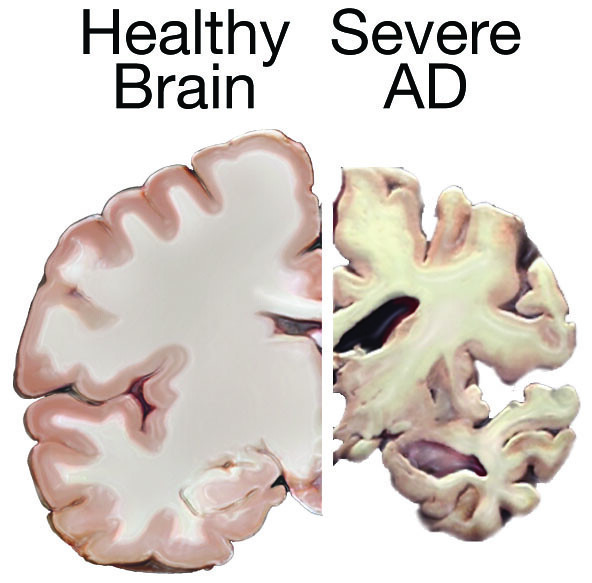
AD develops over many years before memory problems occur. AD gradually causes behavior and personality changes, difficulty recognizing family and friends, and a severe loss of mental function. People with severe AD cannot communicate and are completely dependent on others for their care. There are no treatments that can stop the progression of AD, but medications can temporarily slow its worsening.[4]
Attention Deficit Hyperactivity Disorder
Attention deficit hyperactivity disorder (ă-tĕn-shŭn dĕf-ĭ-sĭt hī-pĕr-ăk-tĭv-ĭ-tē dĭs-ôr-dĕr) (ADHD) is a neurodevelopmental disorder that is typically diagnosed in childhood and often lasts into adulthood. Children with ADHD may have trouble paying attention, controlling impulsive behaviors (i.e., act without thinking about what the result will be), or being overly active. ADHD is treated with a combination of behavior therapy and medication.[5]
Carpal Tunnel Syndrome
Carpal tunnel syndrome (KÄR-păl TŬN-ĕl SĬN-drōm) is a common neurological disorder that occurs when the median nerve, which runs from the forearm into the palm of the hand, becomes pressed or squeezed at the wrist. The median nerve passes through the carpal tunnel, a narrow, rigid passageway of ligament and bones at the base of the hand. The median nerve provides feeling to the thumb, index, middle finger, and part of the ring finger. Compression of this nerve causes the symptoms of numbness, tingling, weakness, and pain.[6] See Figure 16.9[7] for an illustration of carpal tunnel syndrome.
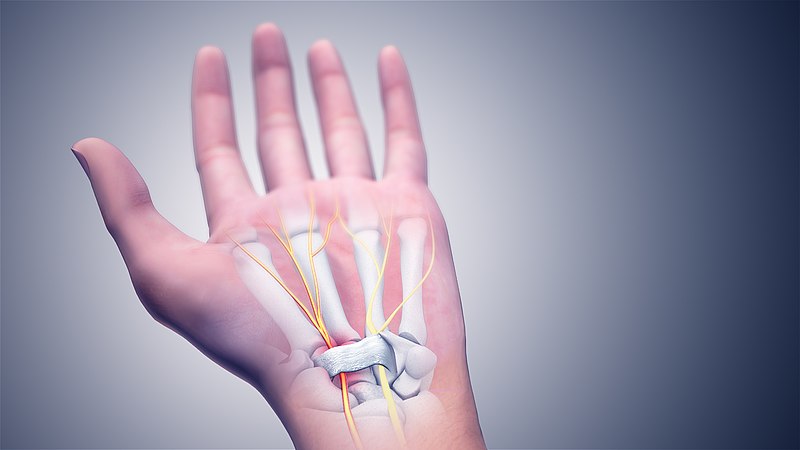
Carpal tunnel syndrome may be diagnosed with a nerve conduction study that measures how quickly impulses are transmitted along a nerve. An electromyography test may also be used, where a fine needle is inserted into a muscle, and electrical activity is viewed on a screen to determine the severity of damage to the median nerve. Treatment includes wearing a splint at night while sleeping to keep the wrist straight and medications to reduce inflammation in the carpal tunnel. If these treatments are not effective, carpal tunnel release surgery is performed to release pressure on the nerve.[8]
Cerebral Palsy
Cerebral palsy is a neurological condition that affects muscles. Read about cerebral palsy in the “Diseases and Disorders of the Muscular System” section of the “Muscular System Terminology” chapter.
Mental Health Disorders
Many mental health disorders, such as anxiety, bipolar disorder, obsessive compulsive disorder (OCD), and schizophrenia can be caused by imbalanced levels of neurotransmitters. Mental health disorders are treated with a combination of medications, psychotherapy, and support groups.
Read additional information about common mental health disorders in the “Disorders of the CNS System” in the “Central Nervous System” chapter in Open RN Nursing Pharmacology, 2e. For more detailed information, view chapters on these disorders in Open RN Nursing: Mental Health and Community Concepts.
Multiple Sclerosis
Multiple sclerosis (MŬL-tĭ-pl sklĕ-RŌ-sĭs) (MS) is a neurological disease with symptom onset generally between the ages of 20 to 40 years. MS is an autoimmune disease causing the immune system to mistakenly attack myelin in the brain, optic nerves, and the spinal cord. Myelin is a substance that coats and protects axons of the neurons. See Figure 16.10[9] for an illustration of MS. MS is a chronic disease that affects people differently. Some people have mild disease with little to no disability, whereas others will have a steadily worsening disease that leads to increased disability.[10]
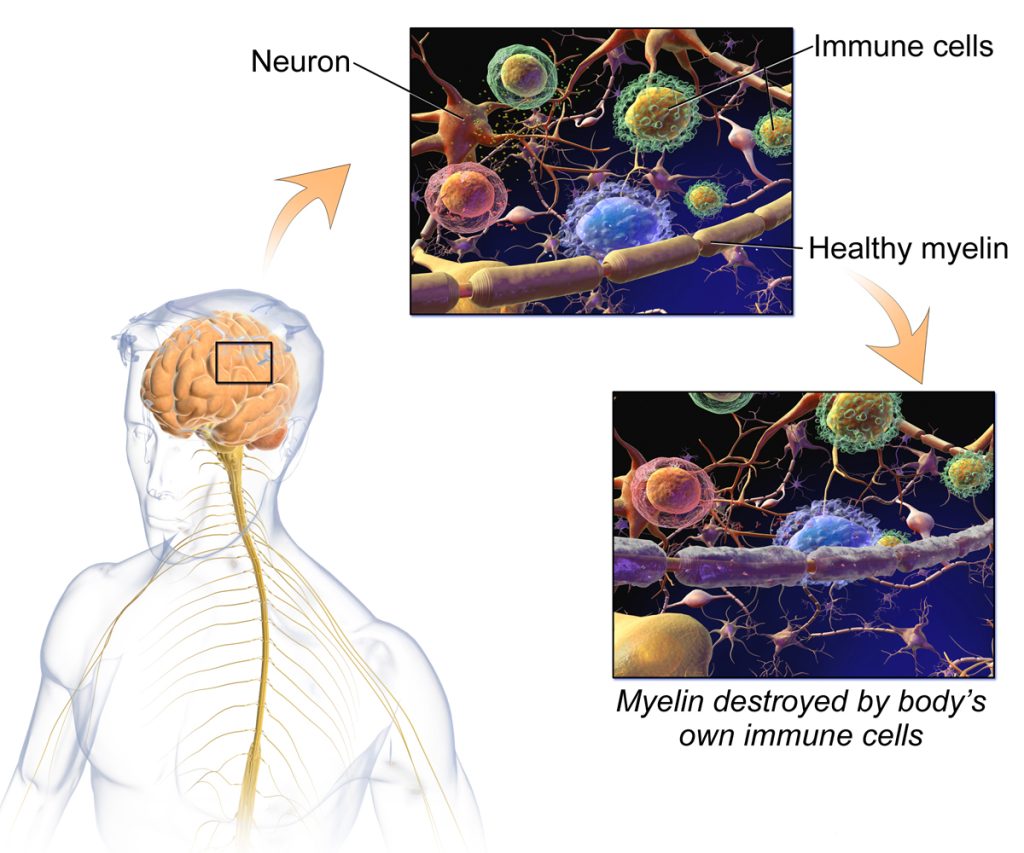
MS symptoms include muscle weakness; vision loss; dizziness; tingling, numbness, or pain in nerves across the body; bladder control issues; and balance problems. There is no cure for MS, but there are medications and treatments that can reduce the number and severity of relapses and delay the long-term disability progression of the disease.[11]
Paralysis
Paralysis is caused by a neurological condition that affects the muscles. Read about paralysis in the “Diseases and Disorders of the Muscular System” section of the “Muscular System Terminology” chapter.
Parkinson’s Disease
Parkinson’s disease (pär-kĭn-sŏnz dĭ-zēz) (PD) is a nervous system disorder that affects movement and worsens over time. As neurons in parts of the brain are damaged, people with PD have symptoms of tremors, rigidity in the limbs or the trunk of the body, slowed voluntary movements, and impaired balance. See Figure 16.11[12] for an illustration of someone with an appearance of typical PD symptoms. As symptoms progress, people may have difficulty walking, talking, or completing simple tasks. There is no cure for PD, but medications or surgery can help improve motor symptoms.[13]
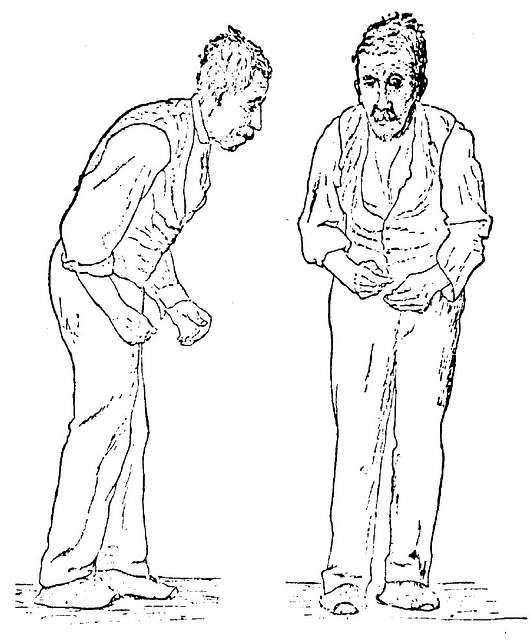
Post-Traumatic Stress Disorder
Post-traumatic stress disorder (pōst-TRŌ-măt-ĭk strĕs dĭs-ôr-dĕr) (PTSD) is diagnosed in individuals who have been exposed to a traumatic event with chronic stress symptoms lasting more than one month that are so severe they interfere with relationships, school, or work. Anyone can develop PTSD at any age, including war veterans; children who have experienced trauma; or adults who have experienced a physical or sexual assault, abuse, accident, disaster, being a refugee, or some other serious event.[14]
Symptoms of PTSD include mentally reexperiencing the event; feeling tense, easily startled, or experiencing angry outbursts; avoiding activities that are reminders of the trauma; and loss of interest in activities one typically enjoys. PTSD treatments include medications, psychotherapy, or a combination of both.[15]
Seizures
A seizure (sē-zhŭrz) is a sudden, uncontrolled electrical disturbance in the brain that causes changes in behaviors, movements, or changes in levels of consciousness. During a seizure, large numbers of brain cells are abnormally activated, like an electrical storm in the brain. Seizures may alter consciousness and produce abnormal motor activity. Symptoms may include muscle jerking; becoming limp or rigid; brief muscle twitching; or changes in sensations, emotions, or thinking. Epilepsy is a neurological disease that causes recurrent seizures. Seizures are diagnosed with electroencephalograms (EEGs), CT scans, and MRIs. Epilepsy is treated with medications.[16]
Stroke
A stroke is also called a cerebrovascular accident (sĕr-ĕ-brō-VĂS-kyŭ-lăr ăk-sĭ-dĕnt) (CVA). It is a sudden interruption of blood flow to the brain and requires immediate emergency care. Diagnosing and treating a stroke is often referred to as “time is brain.” With timely treatment it is possible to save brain cells and greatly reduce the damage or death that can occur due to stroke. Brain cells die because they stop getting the oxygen and nutrients needed to function or they are damaged by sudden bleeding in or around the brain. Knowing the signs of stroke and calling 911 immediately can help save someone’s life.[17]
People who have a stroke may not realize what is happening, ignore the signs, or may not be able to call for emergency help on their own. Call 911 immediately if you notice someone is having one or more of the following symptoms[18]:
- Sudden numbness or weakness of an arm or leg, especially on one side of the body
- Sudden confusion, trouble speaking, or understanding
- Sudden loss of vision or trouble seeing in one or both eyes
- Sudden trouble walking, dizziness, or loss of balance or coordination
- Sudden unusually severe headache with no known cause
There are two types of strokes called ischemic and hemorrhagic. An ischemic stroke is the loss of blood flow to an area because vessels are blocked or narrowed. This can be caused by plaque that has built up and blocked the vessel, or a blood clot that has travelled from another area of the body and lodged in the brain. A hemorrhagic stroke is bleeding into the brain because of a damaged blood vessel. Accumulated blood fills a region of the cranium and presses against the tissue in the brain, referred to as intracranial pressure (ĭn-tră-KRĀ-nē-ăl PRĔSH-ŭr).[19] See Figure 16.12[20] for an illustration comparing ischemic and hemorrhagic strokes, and Figure 16.13[21] for an image containing a radiographic image of a hemorrhagic stroke.
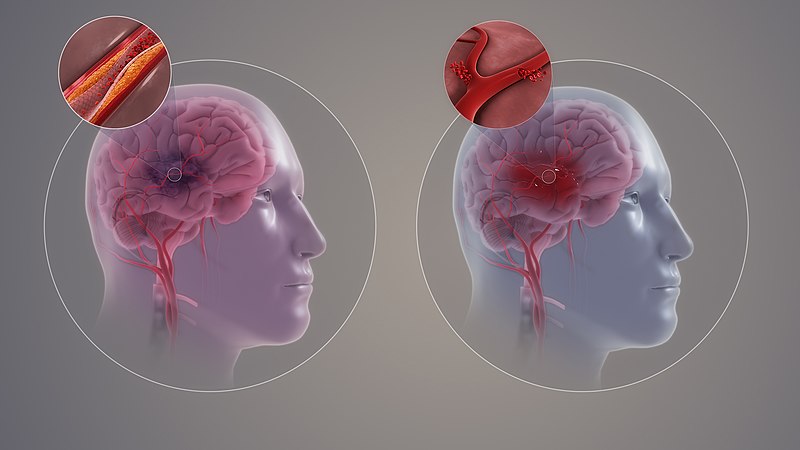
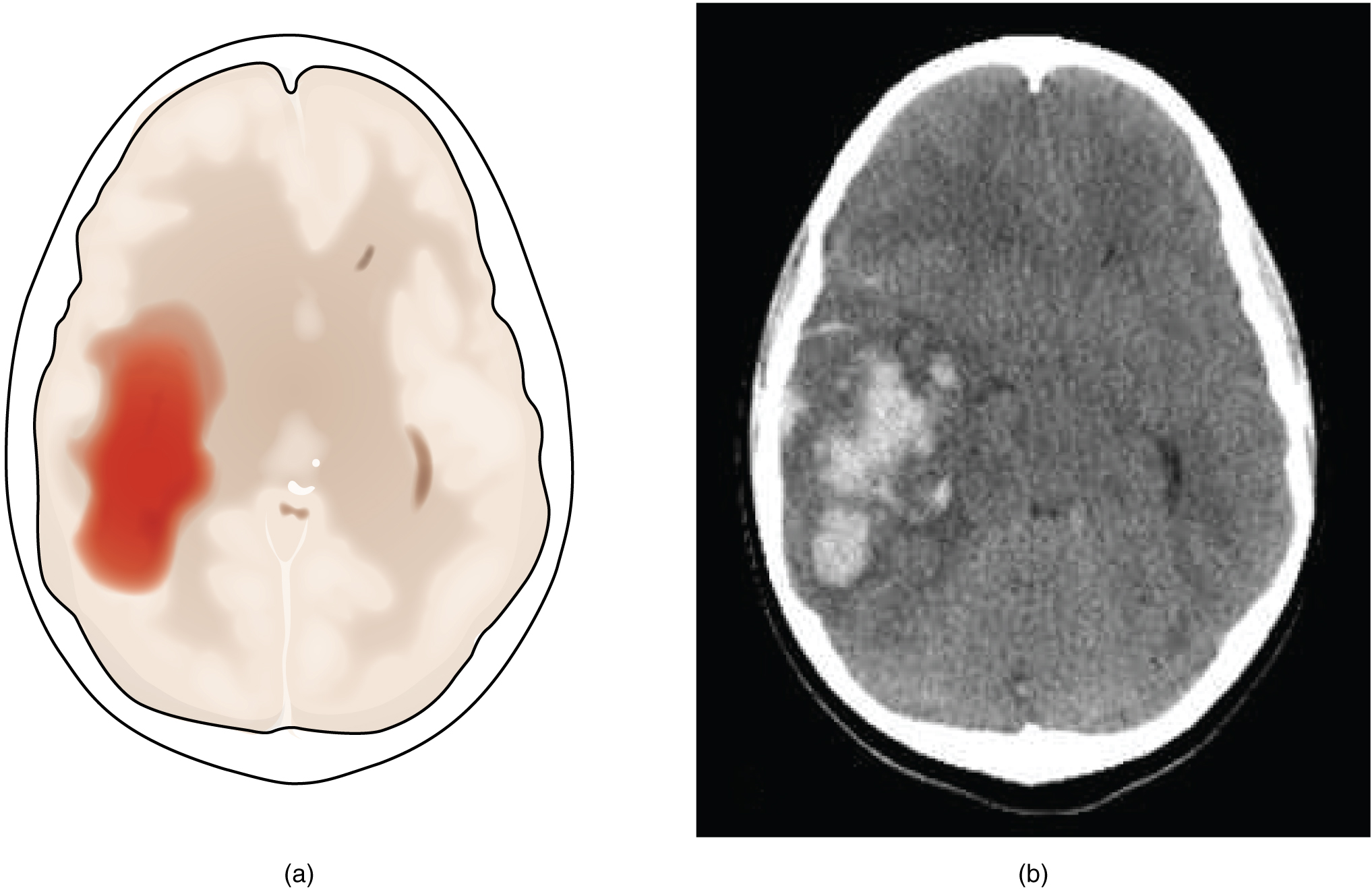
Subarachnoid hemorrhage (sŭb-ă-răk-NOYD HĔM-ŏr-ĭj) refers to bleeding in the space between the brain and the surrounding membrane (subarachnoid space). The primary symptom is a sudden, severe headache, often described by patients as the worst headache they have ever felt.[22]
Transient ischemic attacks (trăn-zhĕnt ĭs-kē-mĭk ă-tăks) (TIAs) are temporary periods of symptoms similar to a stroke, but irreversible damage to the brain cells do not occur. However, TIAs are considered warning signs of an impending stroke and the opportunity to prevent it.[23]
Strokes are often diagnosed with diagnostic imaging tests like CT scans or MRIs. A cerebral angiogram may be performed for an ischemic stroke, where a catheter is inserted into the arteries supplying the brain and a dye is injected to reveal the blockage site. Treatment of strokes depends on the cause and may include medications or surgery.[24]
Traumatic Brain Injury
A traumatic brain injury (trô-măt-ĭk brān ĬN-jŭ-rē) (TBI) can be caused by a forceful bump, blow, or jolt to the head or body or from an object that pierces the skull and enters the brain. Some types of mild TBI, like a concussion, can cause temporary or short-term problems with normal brain function, including problems with how the person thinks, understands, moves, communicates, and acts. A serious TBI can lead to severe, permanent disability or death.[25]
Symptoms of a TBI may include loss of consciousness; headache; blurred vision; unequal eye pupil size; nausea and vomiting; clear fluids draining from the nose or ears; sensitivity to light, a condition called photophobia (fō-tō-FŌ-bē-ă); ringing in the ears; or other neurological symptoms. TBI is diagnosed using standardized concussion tools and diagnostic testing such as CT scans and MRIs, if necessary.[26]
There are many types of TBIs, including concussions, hematomas, skull fractures, and chronic traumatic encephalopathy[27]:
- Concussion (kŏn-KŬSH-ŭn): A concussion is a temporary, mild TBI that may take several months to heal. A concussion can be caused by a blow to the head, sports injury, fall, motor vehicle accident, weapons blast, or a rapid acceleration/deceleration of the brain within the skull, such as an infant being shaken.
- Hematoma (hĕm-ă-TŌ-mă): A hematoma refers to bleeding in and around the brain caused by a ruptured blood vessel. Different types of hematomas form depending on where the blood collects. For example, subdural hematomas (sŭb-DŪ-răl hĕm-ă-TŌ-măz) are common in the elderly after experiencing a TBI from a fall. It involves bleeding below the dura mater, the membrane directly under the skull.
- Skull fracture (skŭl FRĂK-chŭr): Skull fractures are cracks in one or more of the bones that form the skull. They can cause damage to the membranes, blood vessels, and brain under the fracture. Helmets and seat belts significantly help prevent skull fractures and TBI.
- Chronic traumatic encephalopathy (KRŎN-ĭk trô-măt-ĭk ĕn-sĕf-ăl-ŌP-ă-thē): Chronic traumatic encephalopathy occurs in people with extraordinary exposure to multiple blows to the head, such as boxers and football players. It is a delayed consequence after many years and a progressive neurological disorder associated with symptoms that may include problems with thinking, understanding, and communicating; motor disorders (affecting movement); problems with impulse control and depression; confusion; and irritability.
Treatments are based on the cause and severity of the TBI. For example, mild concussions are commonly treated with rest and pain reliever medications, whereas severe TBIs may require surgery to drill a hole into the skull and drain fluids to relieve pressure inside the skull.[28]
- National Institute of Neurological Disorders and Stroke. (2023, November 28). Amyotrophic lateral sclerosis. National Institutes of Health. https://www.ninds.nih.gov/health-information/disorders/amyotrophic-lateral-sclerosis-als ↵
- Alzheimer's Association. (2023). Alzheimer's disease: Facts and figures. https://www.alz.org/alzheimers-dementia/facts-figures ↵
- “Broca’s Area and Wernicke’s Area” by NIH Image Gallery from Bethesda, Maryland, USA is licensed in the Public Domain. ↵
- National Institute of Neurological Diseases and Stroke. (2023, November 28). Alzheimer's disease. National Institutes of Health. https://www.ninds.nih.gov/health-information/disorders/alzheimers-disease ↵
- Centers for Disease Control and Prevention. (2023, October 16). Attention-deficit/hyperactivity disorder. https://www.cdc.gov/ncbddd/adhd/index.html ↵
- National Institute of Neurological Disorders and Stroke. (2023, November 28). Carpal tunnel syndrome. National Institutes of Health. https://www.ninds.nih.gov/health-information/disorders/carpal-tunnel-syndrome ↵
- “Carpal_Tunnel_Syndrome.jpg” by www.scientificanimations.com is licensed under CC BY-SA 4.0 ↵
- National Institute of Neurological Disorders and Stroke. (2023, November 28). Carpal tunnel syndrome. National Institutes of Health. https://www.ninds.nih.gov/health-information/disorders/carpal-tunnel-syndrome ↵
- “Multiple_Sclerosis.jpg” by BruceBlaus is licensed under CC BY-SA 4.0 ↵
- National Institute of Neurological Disorders and Stroke. (2023, November 28). Multiple sclerosis. National Institutes of Health. https://www.ninds.nih.gov/health-information/disorders/multiple-sclerosis ↵
- National Institute of Neurological Disorders and Stroke. (2023, November 28). Multiple sclerosis. National Institutes of Health. https://www.ninds.nih.gov/health-information/disorders/multiple-sclerosis ↵
- “Sir_William_Richard_Gowers_Parkinson_Disease_sketch_1886.jpg” by unknown author is licensed in the Public Domain. ↵
- National Institute of Neurological Disorders and Stroke. (2023, November 28). Parkinson's disease. National Institutes of Health. https://www.ninds.nih.gov/health-information/disorders/parkinsons-disease ↵
- National Institute of Mental Health. (2023, May). Post-traumatic stress disorder. National Institutes of Health. https://www.nimh.nih.gov/health/topics/post-traumatic-stress-disorder-ptsd ↵
- National Institute of Mental Health. (2023, May). Post-traumatic stress disorder. National Institutes of Health. https://www.nimh.nih.gov/health/topics/post-traumatic-stress-disorder-ptsd ↵
- Epilepsy Foundation. (2019, October 1). Understanding seizures. https://www.epilepsy.com/what-is-epilepsy/understanding-seizures ↵
- National Institute of Neurological Disorders and Stroke. (2023, November 28). Stroke. National Institutes of Health. https://www.ninds.nih.gov/health-information/disorders/stroke ↵
- National Institute of Neurological Disorders and Stroke. (2023, November 28). Stroke. National Institutes of Health. https://www.ninds.nih.gov/health-information/disorders/stroke ↵
- National Institute of Neurological Disorders and Stroke. (2023, November 28). Stroke. National Institutes of Health. https://www.ninds.nih.gov/health-information/disorders/stroke ↵
- “Types_of_Stroke.jpg” by https://www.scientificanimations.com/ is licensed under CC BY-SA 4.0 ↵
- “1602_The_Hemorrhagic_Stroke-02.jpg” by OpenStax College is licensed under CC BY 3.0 ↵
- Mayo Clinic. (2022, August 31). Subarachnoid hemorrhage. https://www.mayoclinic.org/diseases-conditions/subarachnoid-hemorrhage/symptoms-causes/syc-20361009 ↵
- Mayo Clinic. (2022, March 26). Transient ischemic attack. https://www.mayoclinic.org/diseases-conditions/transient-ischemic-attack/symptoms-causes/syc-20355679 ↵
- National Institute of Neurological Disorders and Stroke. (2023, November 28). Stroke. National Institutes of Health. https://www.ninds.nih.gov/health-information/disorders/stroke ↵
- National Institute of Neurological Disorders and Stroke. (2023, November 28). Traumatic brain injury (TBI). National Institutes of Health. https://www.ninds.nih.gov/health-information/disorders/traumatic-brain-injury-tbi ↵
- National Institute of Neurological Disorders and Stroke. (2023, November 28). Traumatic brain injury (TBI). National Institutes of Health. https://www.ninds.nih.gov/health-information/disorders/traumatic-brain-injury-tbi ↵
- National Institute of Neurological Disorders and Stroke. (2023, November 28). Traumatic brain injury (TBI). National Institutes of Health. https://www.ninds.nih.gov/health-information/disorders/traumatic-brain-injury-tbi ↵
- National Institute of Neurological Disorders and Stroke. (2023, November 28). Traumatic brain injury (TBI). National Institutes of Health. https://www.ninds.nih.gov/health-information/disorders/traumatic-brain-injury-tbi ↵

